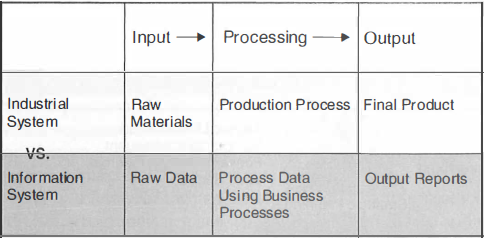Enterprise Resource Planning
 Nowadays, a business management becomes very heterogenous. Every organization will expand their business streams. When they are expanding their business and become a huge company, they will break their functionality into smaller units and will employ more experts. It means their management hierarchy will have more in the operational control management, but they will be under controlled by middle level management, and eventually the middle level management will give their responsibility to the Strategic Planning Management (top level of management). Generally, an organisation has 3 major levels of management which has different roles, namely Top / Senior level management, Mid-level or middle management, and Lower level management, Motiwalla (2009) delineates that Senior management consists of Top managers and Knowledge Workers Professionals, who use ESS (Executive support systems) and DSS (Decision Support Systems) in their Information Systems (IS). Moreover, There are managerial support and Operational support in the Mid-level management, who use MIS (Management Information System) and TSS (Transaction Support System). Lastly, lower level consists of Communication & Collaboration Support & Infrastructure Support (Clerical Staff & IT Staff), who use Office Automation System & ODS (Operating & Database System). (see Fig 1).
Nowadays, a business management becomes very heterogenous. Every organization will expand their business streams. When they are expanding their business and become a huge company, they will break their functionality into smaller units and will employ more experts. It means their management hierarchy will have more in the operational control management, but they will be under controlled by middle level management, and eventually the middle level management will give their responsibility to the Strategic Planning Management (top level of management). Generally, an organisation has 3 major levels of management which has different roles, namely Top / Senior level management, Mid-level or middle management, and Lower level management, Motiwalla (2009) delineates that Senior management consists of Top managers and Knowledge Workers Professionals, who use ESS (Executive support systems) and DSS (Decision Support Systems) in their Information Systems (IS). Moreover, There are managerial support and Operational support in the Mid-level management, who use MIS (Management Information System) and TSS (Transaction Support System). Lastly, lower level consists of Communication & Collaboration Support & Infrastructure Support (Clerical Staff & IT Staff), who use Office Automation System & ODS (Operating & Database System). (see Fig 1).
Fig 1. Management functionality and hierarchy (adopted from Motiwalla & Thompson, 2009, p. 46)
The complexity of their business processes need an integrated system cross their functionality, such as Finance department, HRD (Human Resource Department), Accounting Department, Operation Department, Supply Chain (SC) Department, Customer Services (CS) Department, Sales Department, and many more. An information system (IS), which will take the complex business processes is Enterprise Resource Planning (as known as ERP systems). Generally, Enterprise has 3 stages either in their industrial processes or Information systems, such as:
- Process.
- Output.
Motiwalla & Thompson (2009) shows the differences of process model between industrial and IS (see Fig 1).
Fig 1. Stages of Information Systems (Motiwalla & Thompson, 2009, p. 5).
According to Motiwalla & Thompson (2012), there is an evolution of enterprise systems (ES).
- It was started in the 1960s, a software vendor started to create an Inventory management and control (IMC), which can manage and monitor the inventory from the whole process start from raw materials until inventory reports.
- In 1970s and 1980s , there were Material Requirement Planning (MRP); which help an organisation manage and control their sales and marketing in their business, and Manufacturing Resource Planning (MRP II), which design their strategy in the production and also control the product quality.
- In 1990s, it was started Enterprise Resource Planning (ERP) system, which performs their business processes by integrating cross-department and can produce the better value chain management cross activities.
- In between 2000s, it began with Extended ERP or ERP II, which more concentrate to consumer satisfaction and agility environment in a global business. It will integrate e-Business processes between organisation, their partner and business functions in SCM (Supply Chain Management), CRM (Customer Relationship Management), SFA (Sales Force Automation) , advanced Planning and Scheduling (APS), and many more. Additionally, Singleton (2013) pointed out that Cloud computing is the current trend since 2009, which integrate and controlling cross-functional department into centralization data through web-based infrastructure.
A successful organisation will build a strong Information Systems infrastructure. Every organisations need answer the global competitive market through silo information systems. Many of them implement agile methodology in their business, because they need flexibility and they can change the systems rapidly according to their customer’s need.
Furthermore, a writer will elaborate into several sections, such as:
- What is Shadow systems? What are the positive and negative aspects in the business process? ……………….. ( Click here / week 2 to open discussion page ).
- Best practice of ES Infrastructure. What is the value of ERP systems? What are the risks of using it? ………………………………………………………… ( Click here / week 3 to open discussion page ).
- The implication of adopting ERP systems for an organisation …………………………………………………………………… ( Click here / week 4 to open discussion page ).
- What are the risks of customizing ERP systems? The impact of BPR for an organisation …………………………… ( Click here / week 5 to open discussion page ).
- If an organisation has their in-house legacy system development and feel ailing set of it, is there any possibility of adopting ERP system into their current system..? ……………………………………………………………………………………………………………………..( Click here / week 6 to open discussion page ).
- Issues arise from delivery report?
References
Motiwalla, L.F & Thompson, J 2009, Enterprise Systems for Management, Pearson Education, Inc., New Jersey.
Motiwalla, L.F & Thompson, J 2012, Enterprise Systems for Management, 2nd edition, Pearson Education, Inc., New Jersey.
Singleton, D 2013, History of Manufacturing Software, viewed 28th July 2013, http://blog.softwareadvice.com/articles/manufacturing/manufacturing-software-history-0113/.

